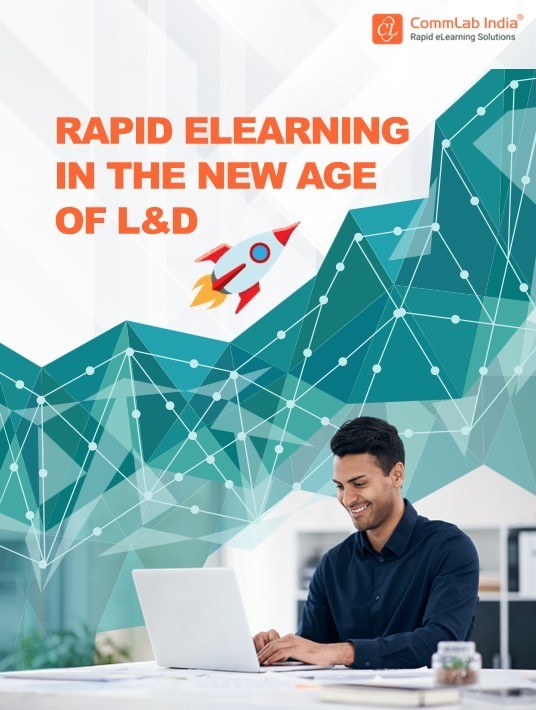Rapid eLearning And Rapid Training Modalities
eLearning courses must address the varying needs and preferences of your multigenerational workforce. L&D teams should make learning engaging by applying modern instructional methods and learning strategies. And if you think this is something rapid eLearning can’t do due to time constraints, read this article on new-age training, and you’ll be pleasantly surprised to find out that you are way off the mark!
Digital learning is the future of corporate training! Both for employees (learners) and Training Managers (stakeholders), it provides a wealth of advantages and prospects. With digital learning, learners may pick and choose from a wide variety of effective training programs and access them from any location. With increased personalization and attention to the skills of each learner, flexibility enables more effective teaching and learning.
Rapid eLearning fits the frame of digital learning very well. It makes way for a personalized and faster-paced avatar of learning. ‘Quick’ learning does not compromise quality. On the other hand, rapid eLearning courses are developed in a short time span, with quality, reducing the cost and time one needs to spend on eLearning course development. Let’s dive right in and explore a few rapid training modalities.

eBook Release
Rapid eLearning In The New Age Of L&D
Have you ever wondered how the use of rapid eLearning significantly impacts business results? Get answers to all your questions!
eLearning
eLearning courses are digital programs that cover a particular subject and are distributed digitally via a learning management system (LMS). Because they adhere to effective instructional design and adult learning principles to increase learner engagement and retention, eLearning courses are viable for all types of training.
Rapid eLearning offers ample scope for creativity and new-age immersive strategies. Here’s a glimpse of how it does so. So put the misconception that rapid eLearning courses are cookie cutters to rest.
Storytelling
It’s important to keep learners interested and immersed in the process of learning, and eLearning needs this to counter the absence of a live facilitator. Stories are the best way to break the monotony and involve learners in ‘doing’ tasks they’ll actually have to do back at work.
Modern rapid authoring tools offer a lot of templates with different backgrounds, characters, and voice clips that make it easy and effective to develop scenario-based eLearning courses. If you are adventurous, try AI-enabled tools for voiceovers – they are evolving now and sounding natural. So, apart from engaging your learners, you won’t have to spend a lot getting professional narrators for each character in the learning scenario/story.
Games
Organizations have started to invest in gamification, realizing the importance of game elements to transform rapid eLearning courses. It helps in retaining information longer and equipping learners with the skills needed in their role. Games work well for standalone eLearning courses, microlearning modules, and even assessments and quizzes.
While good instructional design is required to design a gamified course, development becomes easy thanks to the in-built templates and functionality provided by authoring tools.
Microlearning
Microlearning imparts knowledge by breaking down larger themes into granular topics and presenting them in the form of easily digestible modules. Microlearning helps learners overcome the Forgetting curve when used for spaced retrieval and can be delivered in various formats such as videos, gamified modules, infographics, podcasts, and more. Microlearning is also optimal to deliver performance support tools such as quick job aids and how-to demos. Here’s a bit on how microlearning videos help – but remember, microlearning is much more than just video!
- Microlearning videos offer learners a quick way to access the exact information they need.
- Videos of subject matter experts (SMEs) or senior leadership can be used to convey messages or offer advice to employees.
- Explainer videos can be used to train remote employees on your products.
- Animated videos are a great tool to convey abstract concepts.
And tools such as Synthesia offer virtual avatars, making it easy to develop AI-enabled videos with a guided approach.
Virtual Instructor-Led Training
Virtual instructor-led training (VILT) sessions are conducted using online video conferencing tools such as Zoom, Microsoft Teams, or Cisco Webex – allowing both the instructor and the employee to participate from wherever they are. The challenge with VILT is retaining the classroom collaboration, but most platforms offer a wide variety of options to make virtual classrooms engaging, such as:
- Polls
- Chat
- Whiteboards
- Breakout rooms
Due to their global distribution, firms are increasingly focusing on hybrid or fully remote workforce models. And VILT is one of the most effective methods for providing high-quality, consistent training.
Video-Based Training
Video-based training is a well-liked and efficient digital learning format. It provides a visual and interactive experience that makes learning interesting and simple. From fundamental abilities to intricate processes, video lessons are competent at addressing a broad range of subjects. They support ease, flexibility, and accessibility to improve the learning environment. Experts in their industry can produce video tutorials, guaranteeing the content is precise and current.
Performance Support
Performance support tools are a specialty of rapid eLearning. From micro modules to tools such as how-to videos, interactive PDFs, templates, cheat sheets, and infographics, rapid eLearning can produce tools from existing training material – be it classroom material, legacy courses, webinars, SME recordings, and more,
How Does Rapid eLearning Support New-Age Training?
Rapid eLearning is the best way to achieve scale, speed, and volume in the rollout of digital learning. It leverages the latest authoring tools and their capabilities to bring courses to life. And by ensuring courses are instructionally sound, it delivers courses that appeal to learners of multiple generations and preferences, along with demonstrating immediate, tangible returns to stakeholders. Whether it’s something as small as capturing a learner’s name and addressing them by name throughout the course or as complex as developing a gamified course, rapid eLearning is the faster version of eLearning – and supports modern learning strategies!
Download the eBook Rapid eLearning In The New Age Of L&D today to uncover the secrets for launching a successful rapid eLearning program that doesn’t compromise on quality.

CommLab India Rapid eLearning Solutions
Working with multiple outsourcing vendors can be stressful, and a waste of time & money. With CommLab India Rapid eLearning Solutions, all your online training needs are taken care of, rapidly and economically.



















